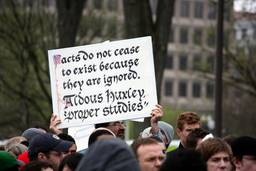Those veteran champions of worker's rights, Republican presidential hopeful Mitt Romney and the Chamber of Commerce, unleashed new attacks this week on the Employee Free Choice Act. They aim to discredit the bill as a death-blow to the economy and workplace democracy while the Chamber ad derides any talk of compromise from new Democratic Sen. Arlen Specter, who opposed the bill as written and now faces a likely Democratic primary challenge.
But in making their case, these pro-business attack dogs have to ignore a powerful new study debunking a central myth of opponents of the pro-union legislation: that it would somehow create a wave of union intimidation. The multi-university study, led by Richard Bruno of the University of Illinois, found that in four states permitting majority sign-up, in over 1,000 campaigns involving 34,000 new union members in the public sector, there wasn't a single confirmed case of either union or employer intimidation.
In fact of course, in the private sector, it's employers who have ramped up their terrorizing of workers who seek to form a union, as shown in the recent "No Holds Barred" report by Cornell labor scholar Kate Bronfenbrenner, which found , for instance, that half of bosses in union campaigns threaten workers in one-on-one "sweat sessions" and a third fire employees.
But it's the majority sign-up provision, dubbed by is opponents as "card check," that has been a primary target for supposedly threatening worker's rights and making them vulnerable to intimidation. (One anti-union group even features a former Sopranos actor playing a union thug in its ads.)
Yet hidden away in plain sight in America is the one part of the economy where workers are free to join unions without intimidation from employers, and they are permitted to use the majority sign-up provision that's been proposed by the Employee Free Choice Act -- and so demonized by Big Business interests. Where is this idyllic land, where rights long granted to European workers and ignored here at home are so freely available? It's in the public sector -- whether they're firemen or nurses -- the difference in union representation shows what a difference organizing rights can make.
Contrary to fashionable conservative arguments that declines in union representation are due largely to globalization and a new post-industrial economy, the stark differences between the public and private sector tell a far different story. Overall, 12.4 percent of U.S. workers are represented by unions. As American Rights at Work has pointed out:
Studies have shown that if workers' preferences were to be realized, as many as 58% would have union representation. Yet this low unionization rate obscures a striking imbalance: In the public sector, where workers' right to a union faces fewer impediments, almost 37% of workers belong to unions, but in the private sector, where workers' face rising resistance from employers, less than 8% of workers are represented by unions.
Is it possible that, for instance, because a third of employers in private sector NLRB elections fire workers it might have something to do with this discrepancy? (Government employees aren't governed by NLRB elections but an alternative labor regulatory system.)
With employers so fearful of intimidation-free elections or majority sign up, it's no wonder that corporate shills are repeating discredited myths about the legislation: The Chamber trotted out again the scare-mongering claim that "Congress wants to strip away the secret ballot…., " although the bill just gives workers the right to choose a majority sign-up option to form a union that's now held by employers; and Romney claimed the legislation would be "catastrophic for the economy."
Yet the Center for American Progress Action Fund and a few dozen of the nation's leading economists , organized by the Economic Policy Institute, have already made mincemeat of those arguments, showing that increasing unionization rates would strengthen the middle-class and boost consumer spending needed to help the economy recover from the recession. As David Madland and Karla Walter pointed out in their report:
One of the primarily reasons why our current recession endures is that workers do not have the purchasing power they need to drive our economy. Even when times were relatively good, workers were getting squeezed. Income for the median working age household fell by about $2,000 between 2000 and 2007, and it could fall even further as the economy continues to decline. Consumer activity accounts for roughly 70 percent of our nation's economy, and for a while workers were able to use debt to sustain their consumption. Yet debt-driven consumption is not sustainable, as we are plainly seeing.
What is sustainable is an economy where workers are adequately rewarded and have the income they need to purchase goods. This is where unions come in.
Yet unions, facing a crisis where a worker is either punished or fired for trying to form a union every 18 minutes, have to overcome not only a broken labor law system but a non-stop blitz against fixing the system. A central part of that lobbying effort is spreading the myth of union intimidation. Some contrasting statistics tell the real story, as noted by the Center for American Progress Action Fund:
In 2007, 29,559 workers received backpay from their employers because they were illegally fired or denied work as a result of exercising their federally protected labor law rights…
Unions have long demonstrated their respectful and lawful treatment of workers.
* Increasingly, unions rely on organizing campaigns where employers voluntarily agree to recognize a union once a majority of workers have signed a card supporting unionization. Since 2003, over half a million workers formed unions through majority sign-up.
* While critics of majority sign-up campaigns claim pro-union workers and union organizers will coerce workers to obtain their signature, they can find few cases of past fraud or coercion by pro-union petitioners. American Rights at Work recently conducted a review of 113 past union petition processes cited by the anti-union HR Policy Association as involving union fraud and coercion. Its examination revealed misconduct in only 42 of the 113 cases occurring between 1938 and 1997--far less than one per year.
So it's little wonder that AFL-CIO President John Sweeney said of the new public sector study of majority sign-up:
"Today's report proves, once again, that corporations are leveling baseless allegations in a desperate attempt to prevent workers who want a union from forming one," said AFL-CIO President John Sweeney. "Unions are the single best ticket in our nation to the middle class for working men and women. "
As the AFL-CIO Now blog underscored the significance of the new study:
The researchers conclude:
"New York, New Jersey, Illinois and Oregon have demonstrated that a majority authorization petition can genuinely determine the will of the employees to be unionized and provides a functional, largely non-adversarial and event-less process for insuring a fair work environment for everyone."
Workers need the freedom to form unions and bargain to get a fair share of the prosperity they create. It's good for workers and it's good for the economy. This landmark study demonstrates once again that workers--not their bosses--should get to choose how to form a union.
Art Levine, a contributing editor of The Washington Monthly, has written for Mother Jones, The American Prospect, The New Republic, The Atlantic, Slate.com, Salon.com and numerous other publications.



